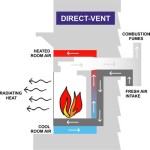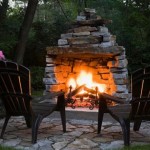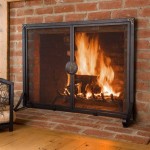```html
Efficient Fireplace Design: Maximizing Heat and Minimizing Waste
Fireplaces, traditionally a focal point for gathering and providing warmth, have evolved significantly. Modern fireplace design prioritizes efficiency, aiming to maximize heat output while minimizing fuel consumption and environmental impact. Several factors contribute to an efficient fireplace, ranging from the overall design and construction to the types of materials used and the incorporation of advanced technologies.
An efficiently designed fireplace not only reduces heating costs but also contributes to a more sustainable lifestyle. By understanding the principles of efficient combustion and heat transfer, homeowners can make informed decisions about fireplace design, ensuring a comfortable and environmentally responsible heating solution.
Optimizing Firebox Design for Complete Combustion
The firebox, the heart of the fireplace, plays a crucial role in combustion efficiency. The shape, size, and materials used in the firebox directly impact how effectively fuel burns. A shallower firebox, for instance, reflects heat back into the fire, promoting more complete combustion. Deeper fireboxes can lead to incomplete burning and increased smoke production.
The use of refractory materials, such as firebrick, within the firebox is essential. Firebrick can withstand high temperatures and radiate heat back into the combustion zone. This radiant heat helps to ignite unburned gases and particles, leading to a cleaner and more efficient fire. The placement of these materials is also important. Strategic placement near the back and sides of the firebox maximizes heat reflection and promotes even burning.
Furthermore, the integration of an air supply system specifically designed for combustion is critical. This system should deliver preheated air to the firebox, ensuring a sufficient oxygen supply for efficient burning. Many modern fireplaces incorporate air intakes strategically positioned to draw air from outside the home, preventing the consumption of heated indoor air and further improving efficiency.
Harnessing Heat with Advanced Heat Exchangers
Traditional fireplaces often lose a significant amount of heat up the chimney. Efficient fireplace designs incorporate heat exchangers to capture and redirect this escaping heat back into the living space. These exchangers can take various forms, from simple metal tubes surrounding the chimney to more complex systems that circulate air or water.
Air-circulating heat exchangers typically consist of a series of metal tubes or channels that surround the chimney. As hot flue gases pass through the chimney, the metal absorbs heat, which is then transferred to the surrounding air. A fan can be used to circulate this heated air back into the room, increasing the overall heating efficiency of the fireplace. Water-circulating heat exchangers, on the other hand, use water to absorb heat from the flue gases. The heated water can then be used to supplement the home's central heating system or to provide hot water for other purposes.
The efficiency of a heat exchanger is determined by factors such as the surface area, the materials used, and the flow rate of the circulating fluid (air or water). Larger surface areas and materials with high thermal conductivity promote better heat transfer. Careful design and installation are essential to ensure optimal performance and prevent potential safety hazards.
Controlling Airflow for Optimized Performance
Airflow management is a critical aspect of efficient fireplace design. Proper airflow control ensures that the fire receives enough oxygen for complete combustion while preventing excessive heat loss up the chimney. A well-designed damper system is essential for regulating airflow.
A traditional damper, located at the base of the chimney, can be adjusted to control the amount of air flowing through the fireplace. However, traditional dampers are often leaky, allowing significant heat loss even when closed. Top-sealing dampers, installed at the top of the chimney, provide a tighter seal and can significantly reduce heat loss when the fireplace is not in use.
In addition to dampers, some efficient fireplace designs incorporate adjustable air inlets that allow the homeowner to fine-tune the airflow to the fire. This enables the user to optimize combustion for different types of fuel and varying weather conditions. Careful control of airflow not only improves efficiency but also reduces smoke production and creosote buildup in the chimney, minimizing the risk of chimney fires.
Furthermore, the chimney design itself plays a role in airflow. The height and diameter of the chimney must be properly sized to ensure adequate draft. An undersized chimney may not provide enough draft, leading to poor combustion and smoke backdrafting into the room. An oversized chimney, on the other hand, can create excessive draft, leading to rapid heat loss.
By carefully considering factors such as firebox design, heat exchangers, and airflow control, homeowners can create efficient and environmentally responsible fireplaces that provide warmth and ambiance while minimizing fuel consumption and environmental impact. Regular maintenance and proper operation are also crucial for maximizing the efficiency and safety of any fireplace system.
```:max_bytes(150000):strip_icc()/__opt__aboutcom__coeus__resources__content_migration__treehugger__images__2012__01__rumford-details-0c80e2d578fd400c8340d7c652246a68.jpg?strip=all)
Ids12 The Return Of Rumford Fireplace As An Efficient Prefab

What S The Most Efficient Fireplace In Fort Collins Co

Masonry Stoves Heaters And Fireplaces Build Your Own

Rumford Fireplace Wikipedia

5 Fireplace Design Ideas That Will Enhance Your Home

Our S High Efficiency Fireplaces Valcourt

The Best Wood Burning Fireplace Inserts Or Stoves Ecohome
The Secret To A Warm Fireplace Dale Anderson Masonry Wisconsin Brick And Stone Masons

Living Room Hanging Fireplace Design Photos And Ideas Dwell

5 Urban Legends About The Efficiency Of Fireplaces
Related Posts








